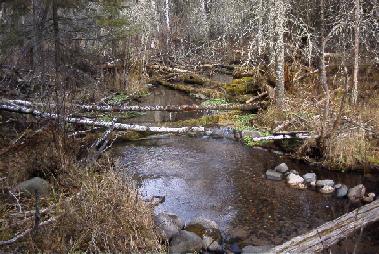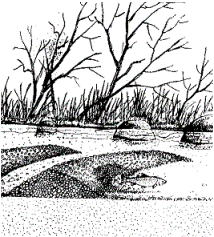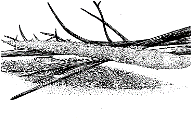Brule River fishery facts
Fishing Wisconsin
The Bois Brule River is one of Wisconsin's best-known trout streams. At the time of European settlement (1850s) the Brule was already regarded as one of the finest brook trout fishing streams in the state. Wisconsin's settlement push reached the Brule's remote location last (mid-1880s) so its fishery was correspondingly impacted much later by angler overharvest and logging practices.
 Lake Run Brown Trout
Lake Run Brown TroutDuring this time period, the majority of the fishery existed in the section of the stream from the town of Brule upstream to Stone's bridge. Brook trout are the only salmonid native to the Brule. Two different brook trout life histories were present originally with the great majority being of the stream resident type (those spending their entire lives in the river). Lake run brook trout (coasters) were also present to a minor extent in the very early history of the fishery but have not been seen since the early 1900s. Anglers have been continuously concerned about the declining condition of the Brule fishery since the 1890s. In response to the fishery decline, locals stocked rainbow trout and brook trout beginning in the mid-1890s. Brown trout were added in the 1920s and coho, chinook and pink salmon first established reproducing populations in the Brule in the 1970s from stocks introduced elsewhere in the Lake Superior basin.
 Restored in-stream habitat on Stones Bridge tributary.
Restored in-stream habitat on Stones Bridge tributary.Today's fishery consists of a unique blend of both native and non-native salmonid species exhibiting both resident and lake run life histories. The present salmonid fishery is self-sustained by natural reproduction. Besides the upper river stream resident fishery, the Brule has become a very important spawning and rearing area for lake run salmonids. About 33,000 angler visits are made annually on the river with about 27,000 of these trips targeted at the lake run salmonids (steelhead, brown trout and coho salmon) on the lower river downstream of Highway 2 during the spring and fall. The majority of the remaining 6,000 trips target the upper river stream resident salmonids (brook, brown and rainbow trout).
Angler overharvest has long been the major limitation to the conservation of good fishing in both the resident and lake run portions of the fishery. Angling regulations have become progressively more restrictive as time passes in an attempt to adjust to the growing numbers of anglers fishing for static numbers of trout. Angling regulations on Lake Superior tributaries are more complex than those on inland Wisconsin trout streams because of this unique mix of variably maturing stream resident and lake run trout and salmon. Today's regulations are designed to allow trout the opportunity of reproducing at least once before they are available for harvest.
 Conceptual drawing of artificial spawning habitat.
Conceptual drawing of artificial spawning habitat.Active fisheries management programs include stocking evaluations, trout habitat improvement, salmonid population monitoring, sea lamprey and beaver control.
Trout stocking is an activity that began in the 1890s on the Brule River and was, for the most part, curtailed in the early 1980s. Recently an experimental stocking project utilizing wild Brule River strain steelhead was carried out from the late 1980s through the early 2000s. Several different life histories were stocked into the Brule River to evaluate the effectiveness of this management tool in enhancing migratory fish populations. The present strategy for sustaining and enhancing trout populations is to improve their ability to restore their populations naturally by revitalizing both spawning habitat and living space. The great majority of available spawning areas in the rivers upper half has been either restored, improved or are currently in the planning stages of being improved.
 Wood is an important component of in-stream habitat.
Wood is an important component of in-stream habitat.Habitat improvement has been shifting more recently toward restoring living space. Adding large woody instream cover is being emphasized in the next phase of fisheries management activities. Beaver populations are being controlled on the upper reaches of the stream and tributaries in order to provide trout access to spawning areas and to protect the quality of instream trout habitat. Salmonid populations are monitored by electrofishing (at index stations throughout the watershed), video monitoring (at the sea lamprey barriers fishway window) and at times with angler creel census. A sea lamprey barrier is operated on the river's downstream end. This structure prevents adult sea lamprey from swimming upstream (where they would reproduce) and reduces the Lake Superior population of these non-native fish parasites.
